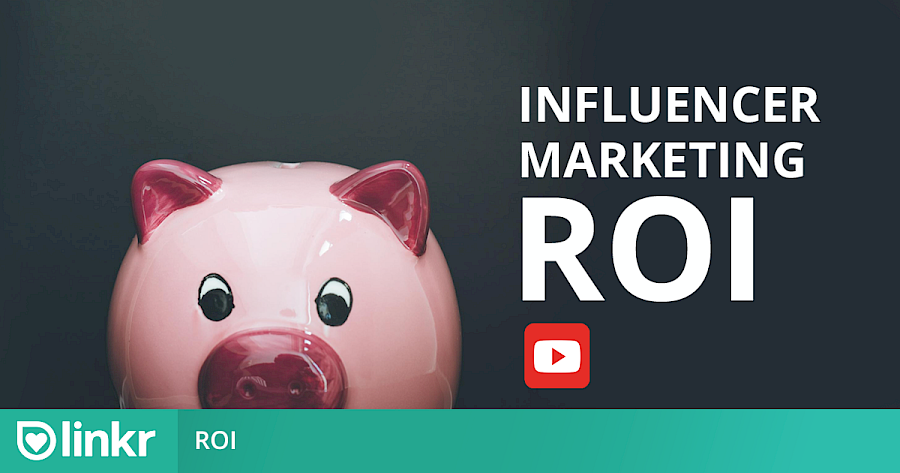In one of our previous articles, we‘ve had a closer look at the ROI of Influencer Marketing on Instagram. We started with a general definition of the term „ROI“ itself and then took a deep dive into the metrics relevant for Instagram, when trying to assess the ROI of your Influencer Marketing campaigns. This article here will not repeat the more general concepts outlined in the initial article but instead, will focus on the specifics inherent to YouTube as a channel for your campaigns.
YouTube is one of the most important marketing channels. It comes second to Instagram in terms of influencer marketing choice. And as more people are coming in, waiting for their favorite vloggers to upload content, there’s no question that working with YouTubers, even those with a few thousand followers, means considerable brand exposure.
One of the best things about YouTube influencers is they’re often niche focused. Because they focus in a field, their audience is also relatively homogeneous. Meaning, the audience is composed of people with similar interests. Thus, you can get high quality engagement and high conversion rates. And to make sure you’re actually getting the right engagement and conversion, you’ll have to monitor the influencer marketing ROI.
However, it’s not as easy as enlisting vloggers, asking them to feature your new product in a review, unboxing or hands-on test or casual mention, and expecting sizable return on investment. Just like with influencer marketing on Instagram, you have to set goals and identify key performance indicators. There are a few things that you have to take into account when calculating the ROI for influencer marketing on YouTube.
Why should you calculate the ROI anyway?
The reason is simple. You want to maximize every dollar spent on influencer marketing on YouTube or any other platform. Moreover, you want to get results for all the money and effort put into the campaign.
Defining ROI the right way
Many marketers think of ROI as simply the amount of money gained in an investment. While it means the ratio of the profit to the investment if the goal of your influencer marketing campaign was to drive sales up, there are other ways to measure ROI. For instance, when the reason you outsourced content to YouTube influencers was to make people know about your brand, then measuring influencer ROI has to primarily include change in web traffic or search volume.
What makes calculating ROI for influencer marketing on YouTube different?
YouTube is a video sharing platform, and that alone makes it inherently different from social media sites like Facebook or Instagram. If you want to watch high quality video, there’s nothing more reliable and faster than YouTube. People also tend to watch a product unboxing and demo on video than to read about it on a blog. However, collaborating with a YouTuber demands more time and resources. It takes a few minutes to edit an Instagram photo and write a nice caption about it. It takes hours or days to record and edit a video, on the other hand.

Although the ideal YouTube video length varies depending on the nature and purpose of the video, the fact remains that a video demands much more viewing time than a photo does. On Instagram, you can marvel at the gorgeousness of a photo for a few seconds before you hit like or write a comment or check out the brand website or page. It’s easy to create brand awareness with still images.
On YouTube, your view can be counted even though you clicked another video before you heard the call to action or saw the product mentioned. If the purpose of the video was to generate brand awareness, then it failed in its intention if viewer retention was low.
Having said that, we think it’s essential that you take KPIs into account when evaluating ROI:

Number of Video Views
Most video marketers judge the success of video marketing by the number of views. If you’re working with an influencer, you at least have a good grasp of the resonance of their campaign based on the number of views. You can then easily tell if their content is working. This is especially helpful when you’ve enlisted multiple influencers. You can compare whose video campaign gets the most views.
The great thing with YouTube is that, in addition to the views that YouTubers get from their followers, they likely get views from keyword-based searches on Google. YouTube is owned by Google and Google lists YouTube videos rather prominently as part of its search results. So other than on e.g. Instagram, where content has a lifecycle of several hours, well-made YouTube videos can drive views for months after they‘ve initially been published.
However, views are just a slice of the cake. The other indicator, perhaps sharing the same prominence as the number of views, is the average watch time.
Average Watch Time
There are at least two ways to measure average watch time. You can measure total watch time for all videos included in your massive influencer campaign on YouTube, or you can take note of individual watch time for each video for comparison purposes.
High view counts and low average watch time are a bad combination that should urge you to look into the content your influencers are making. Another red flag is significantly lower watch time for branded content in comparison to regular content. Possible reasons for both scenarios are dishonest titles and descriptions and misleading thumbnails.
Nevertheless, check out the most and least viewed branded video content to get a glimpse of how the audiences are responding to influencer content. The data should guide you in improving your marketing strategy.
While the watch time tells you how long people watch the videos on average, it doesn’t tell you how much of the video they actually watch. This takes us to the next important metric.
Audience Retention
You may think that an average daily watch time of about 165 minutes is long enough, but once you add in total views of 1250, that gives us roughly 8 second of viewing time per viewer. That’s great if your video was only 10 seconds long. If your video, however, was 5 minutes long, that means it struggled awfully in terms of viewer retention. The average YouTube view duration is 50-60% of the video. If your influencers viewers click another video just several seconds into the intro, then it gives you an idea about the quality of influencer video content, or the lack thereof.
Suppose your video was doing well in terms of views and watch time. The next thing you should be concerned about is what the viewers’ reaction is. Did they like the video? Did they dislike the video? Was the content interesting enough to make them leave a comment? These are why the next metric is important.
Engagement
When it comes to social media and influencer marketing ROI, engagement is the performance indicator that keeps coming back. It’s an important metric that tells us how well your influencer video campaign is doing. When we’re looking at the performance of a video, we check the likes, dislikes, comments, and shares aside from just plain views. Although we can’t please every viewer, we hopefully want every video to have much more likes than dislikes. More dislikes than likes are an invitation to scrutinize video content and optimize future campaigns. After all, you don’t want to spend money on collaborations only to see branded YouTube content getting bad reception.
Web Traffic
The goals of influencer marketing on any platform are generally to make people aware a brand exists, to make people consider a brand, to make them buy the product, and to foster brand loyalty. We usually measure ROI based on these goals, and there may be different ways to determine whether a goal was achieved. For example, web traffic from YouTube at the very least indicates brand awareness and can indicate product interest or even intention to purchase. That’s why it’s important to know whether your YouTube influencers are able to drive the audience to your website.
However, the conclusions you can drive from an e.g. view-to-visit ratio are subject to the type of content created. For example: If the YouTuber just did a 10-minutes video that reviews every aspect of your product in great detail, there might not be a need for anyone to check out your product detail page to get even more information. So there might be product interest but simply no need to go to your site right away and therefore no visit.
Sales
Are the campaigns led by your YouTube influencers making people buy your product? When the goal is to increase conversion, then your task is to calculate the number of sales in form of products sold, downloads, or paid subscriptions against number of sessions or visits. However, calculating a pure sales-goal-driven ROI is more complicated than you might think - or at least, there are more things to consider than $ earned vs $ spent. We‘ve had a detailed look on things such as traffic quality, retargeting, conversion and attribution in this article.
The reason we’re measuring influencer ROI is to see whether the campaigns are working to get substantial views, retention, and engagement or to increase web traffic, subscriptions, and conversion. After all, you don’t want to spend your influencer marketing budget without knowing whether the results are worth the money.
To wrap it all up, we have to emphasise the importance of 3 core principles, as already mentioned in our first article on Influencer Marketing ROI:

Long-term: The nature of your cooperations determines how you will measure the ROI of influencers. Since we recommend building relationships with influencers, then tracking your ROI continuously is the logical approach. This is of special relevance for sales-based ROI calculation, considering what we‘ve learned about attribution windows.
Goal-based: As mentioned earlier, only measure ROI based on your goals. If the goal was to raise brand awareness, don’t move the goalpost by assessing sales and judging the health of your collaborations using sales data.
Data-driven: Collecting all the data required to be able to measure the metrics mentioned above is easy if you’re working with one or two influencers. However, we’ve established how important it is to partner with multiple micro-influencers. These multiple partnerships make tracking the ROI of each partnership and each campaign more challenging, due to the increased overhead involved. That’s where influencer marketing automation comes in.



